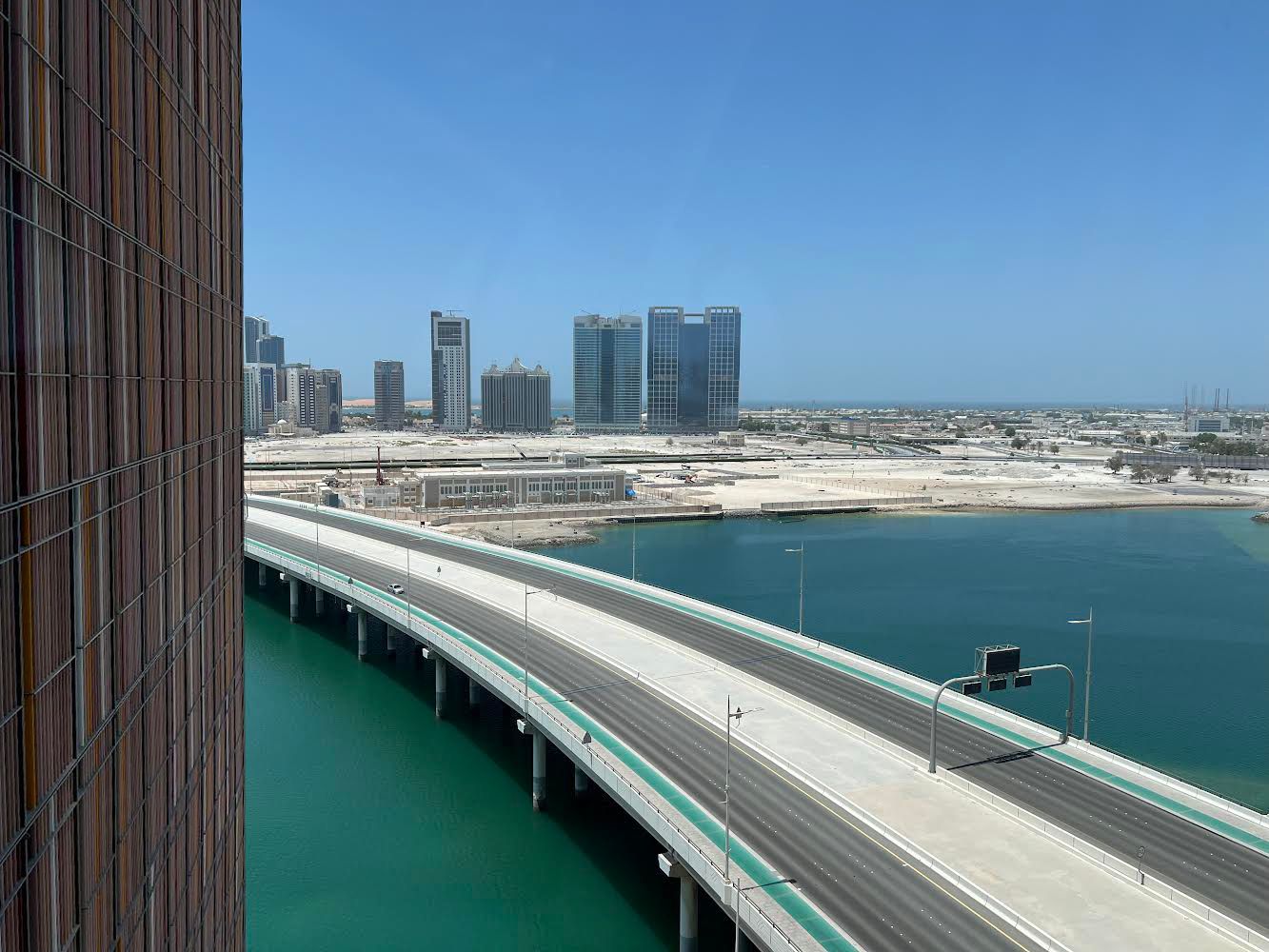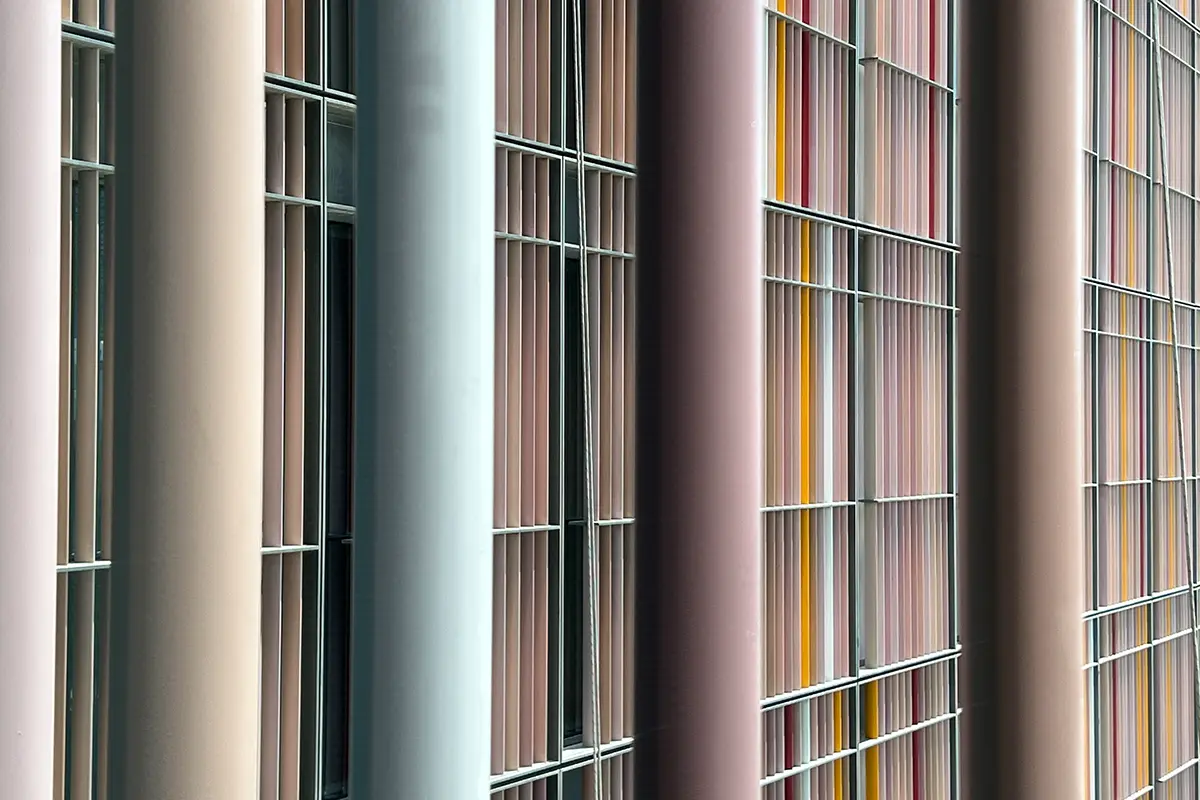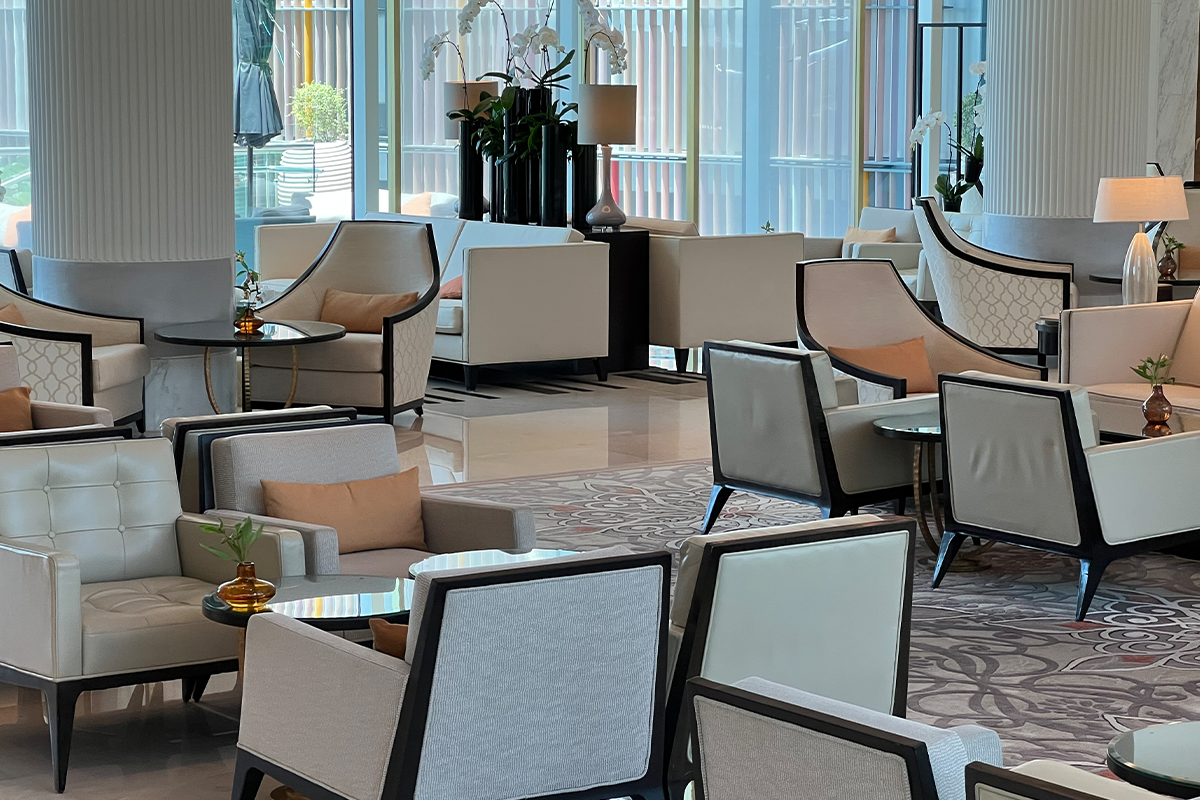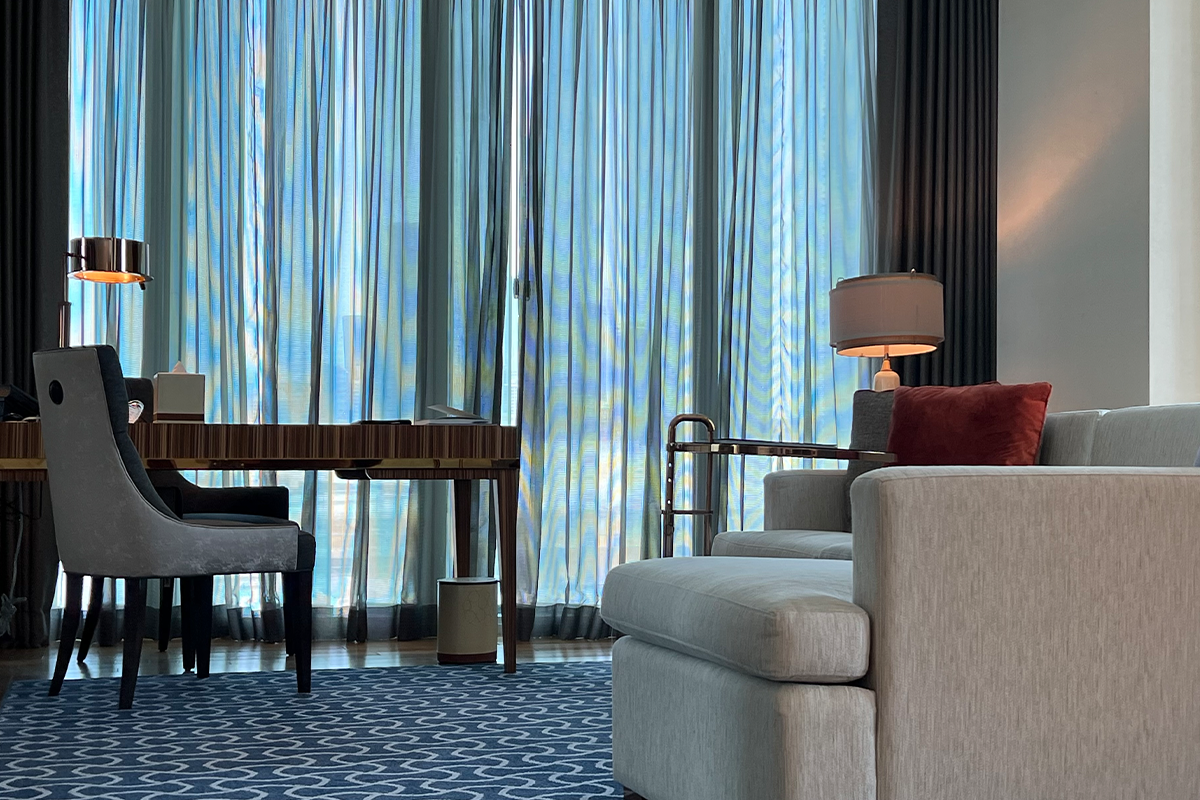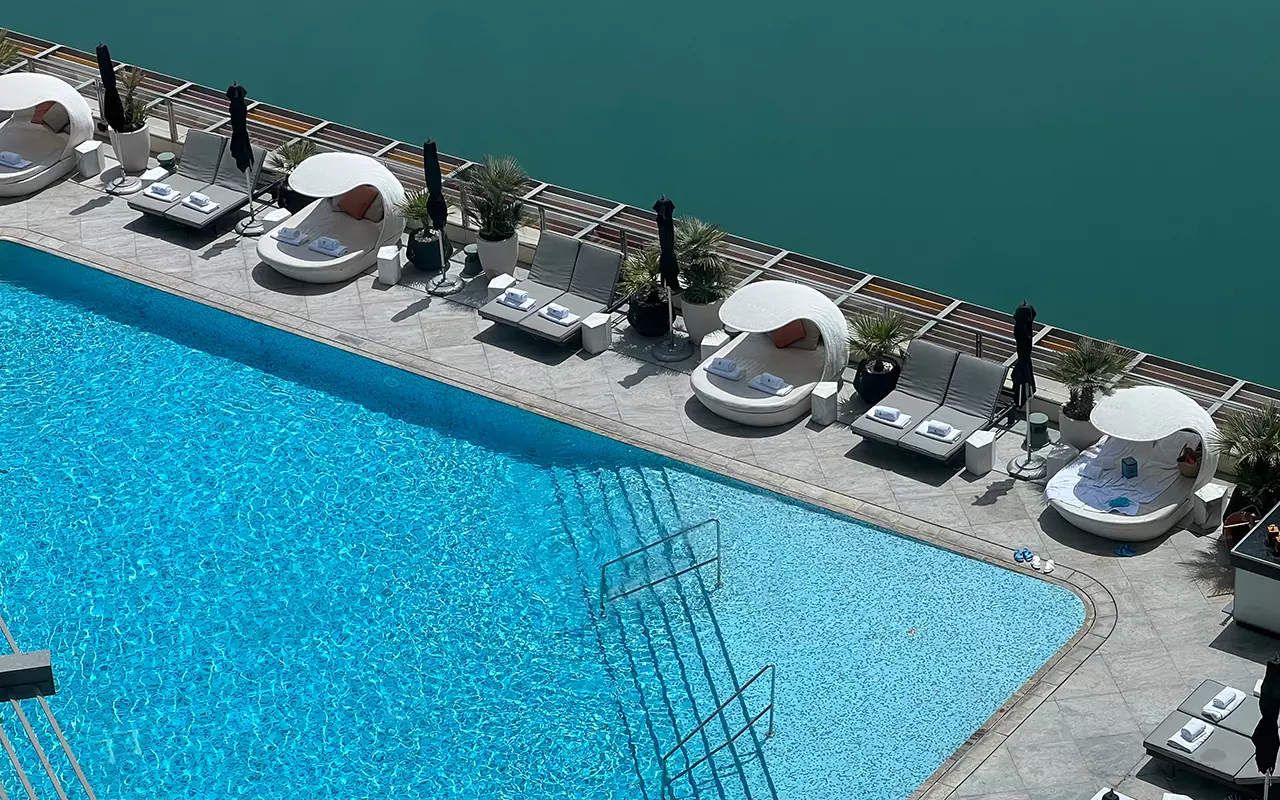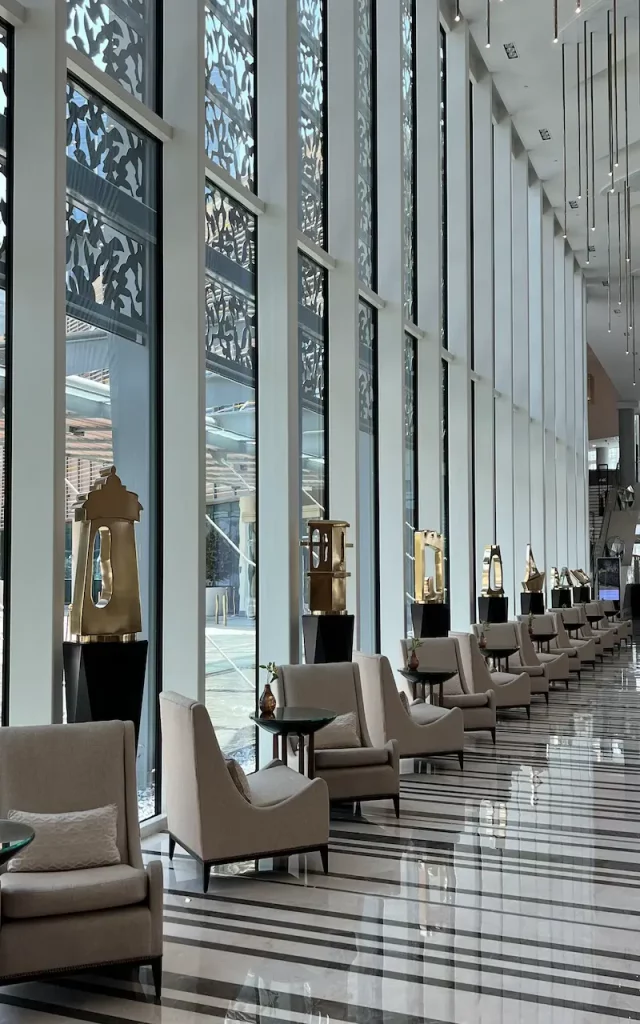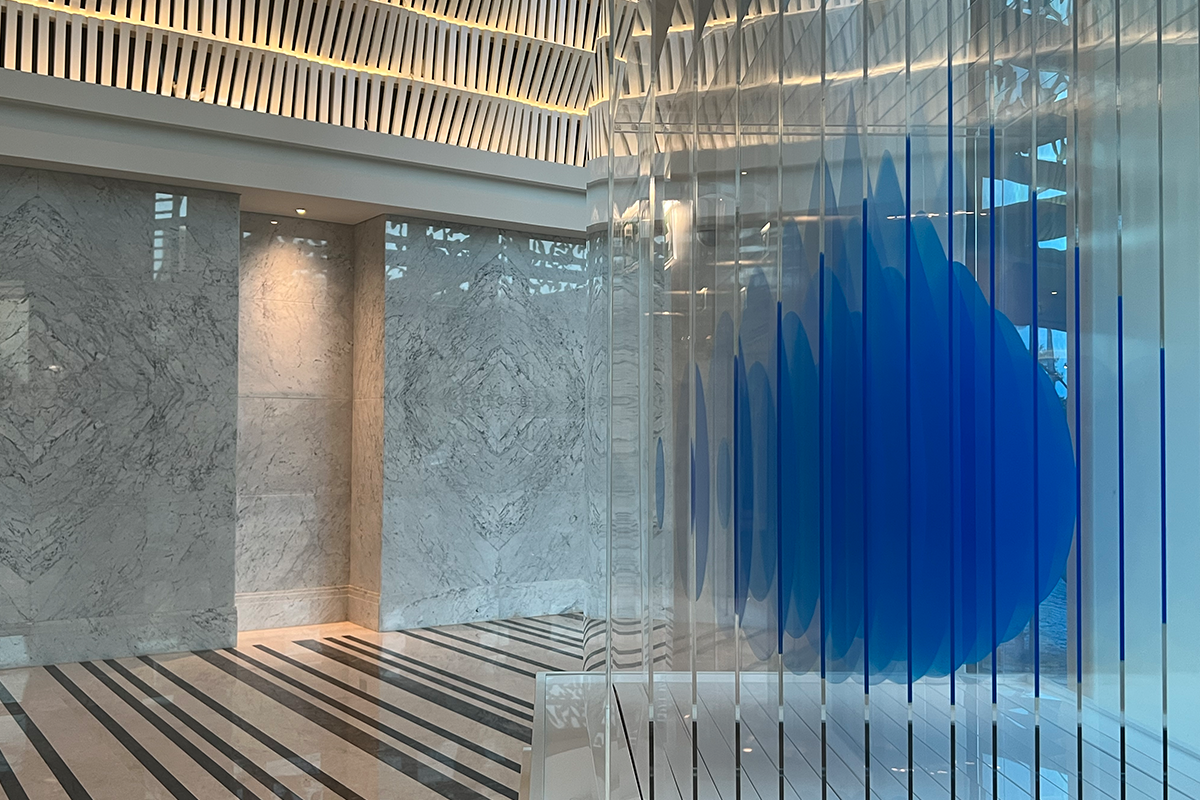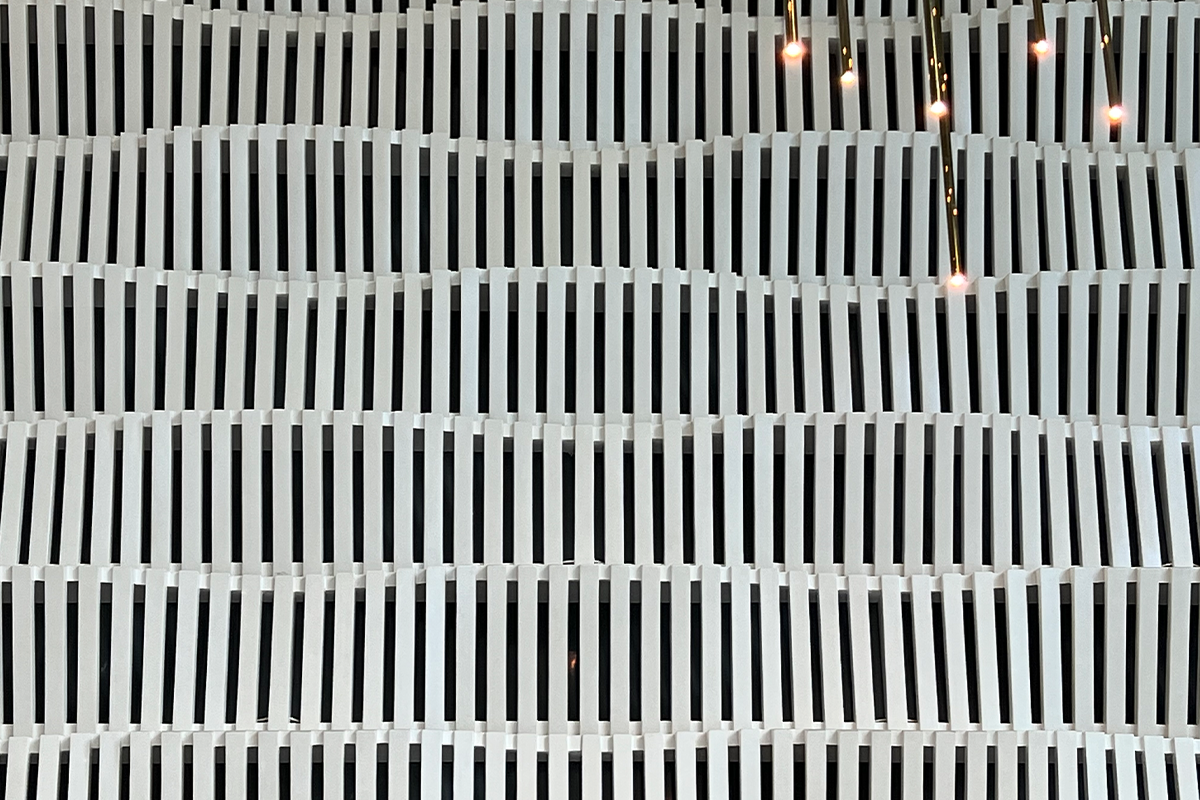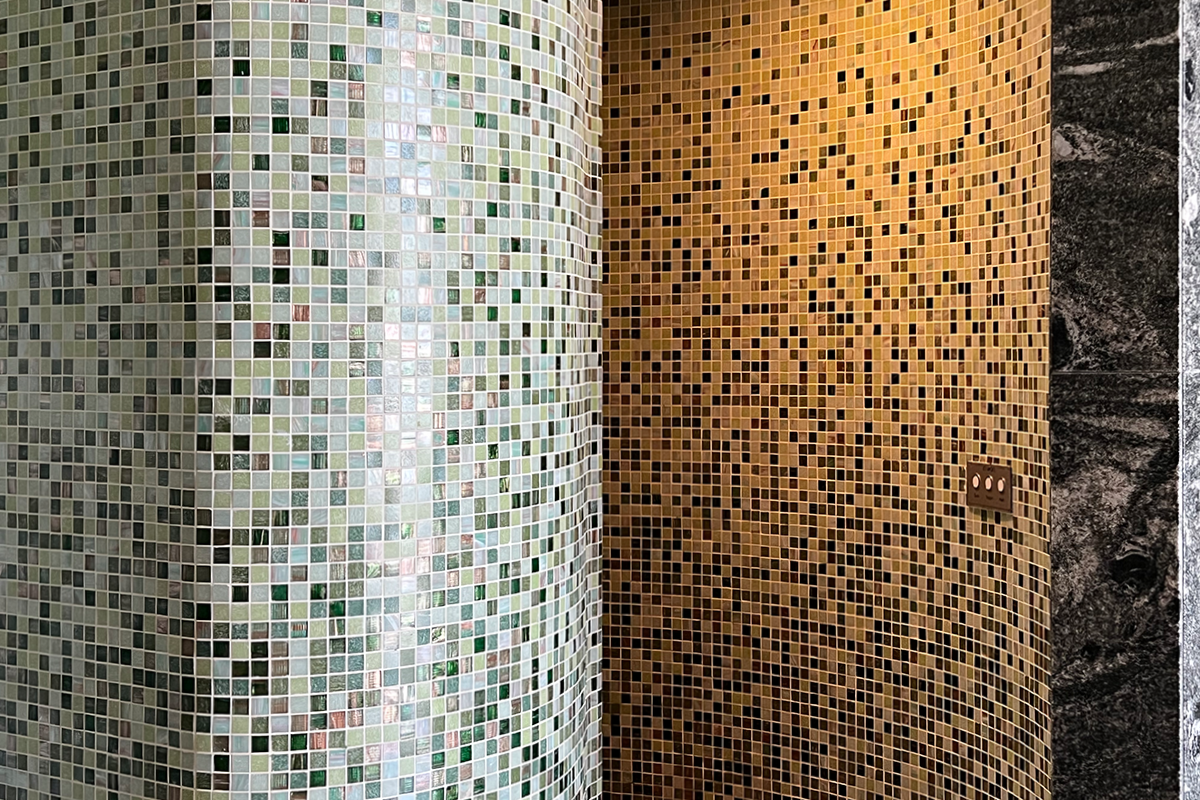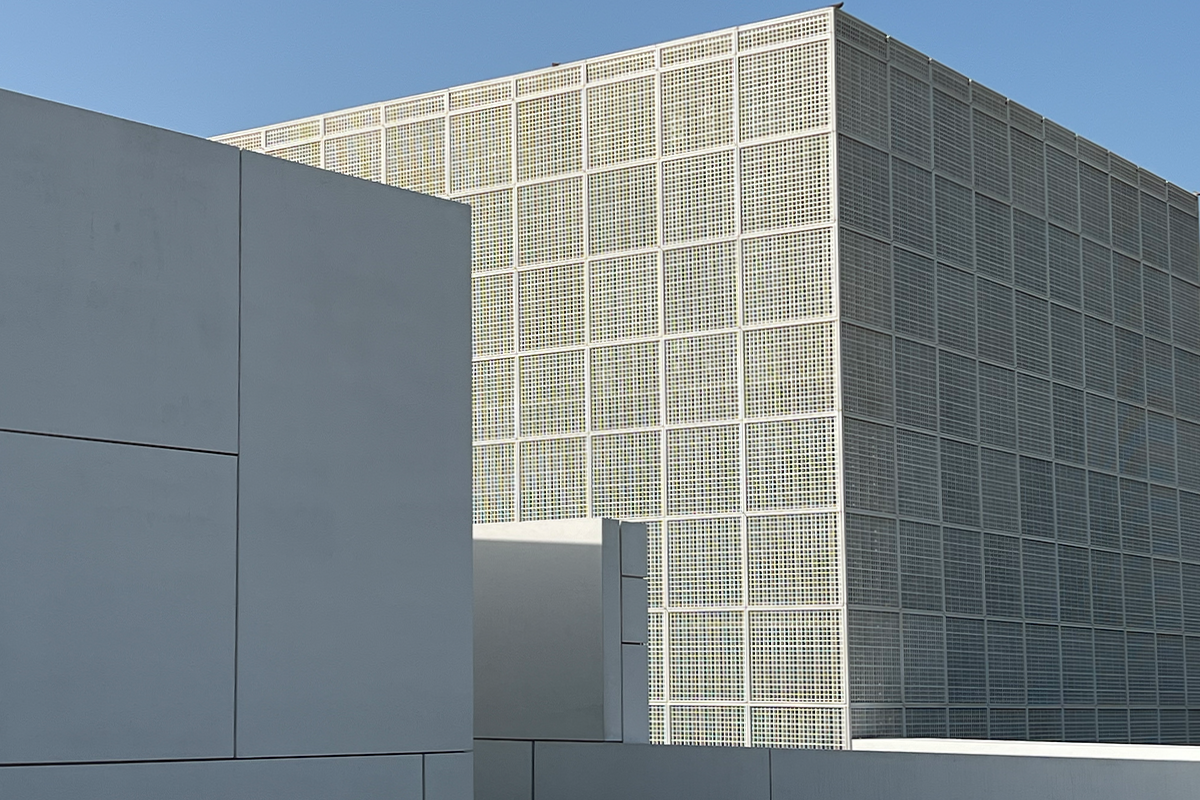Vertical colorful panels run through the 34 floors of the Four Seasons Abu Dhabi at Al Maryah Island, GM Bob Suri introduces the hotel and its design that echoes Middle Eastern tradition and projects itself into the future
Al Maryah Island is one of Abu Dhabi’s hubs – between Eastern modernist architecture and newly constructed buildings stands Four Seasons Abu Dhabi
Large bridges and roads connect the islands Abu Dhabi was built on. From the car, out the window, the view is lost on the horizon, in a line where water and land blur-especially in summer, when the air is rarefied by humidity. On the opposite side, there is the geometry of the skyline: the silhouettes of the tall buildings testify to the grandeur of the city, which underwent a major expansion in the 1970s and 1980s.
Twentieth-century Middle Eastern modernist architecture mingles with the lines of recently constructed buildings. These include the building of the Four Seasons Abu Dhabi, on Al Maryah Island. The hotel opened its doors in 2016.
Abu Dhabi Global Market Square international financial center is located in Mariyah Island, as well as the biggest mall in Abu Dhabi, directly connected to the Four Seasons Hotel
Al Maryah – this natural island is named after an oasis region of Abu Dhabi, which in turn is named after a species of Arabian deer that inhabits it – Al Maryah. The 114 hectares of this island house a nerve and strategic center of the city. Indeed, the Abu Dhabi Global Market Square international financial center is located here. Construction began in 2007 and it became fully operational in 2015.
The ADGM regulates the trading of digital assets and is a prominent jurisdiction for cryptocurrency companies. Another attraction on Al Maryah Island is The Galleria, Abu Dhabi’s premier lifestyle destination, offering shopping, dining, and entertainment-400 stores, including 100 eateries in 380,000 gross square meters. Four Seasons Abu Dhabi enjoys direct internal access to the mall.
Lampoon interviews Mr. Bob Suri, General Manager at Four Seasons Abu Dhabi on sustainable architecture and design
«The Four Seasons Abu Dhabi contains two-thousand pieces of art, but it’s a piece of art itself», begins to tell General Manager Bob Suri, referring to the structure’s exterior design, anchored in traditional Islamic architecture but projected into the future. The building, built from scratch, features vertical panels along all 34 floors: «the colorful lines are inspired by the textiles of Middle Eastern souks. The building was designed to embody the vision of the father of the nation Sheikh Zayed for a responsible development of the capital of the United Arab Emirates», Mr. Suri points out.
In collaboration with Mubadala and the Abu Dhabi Urban Planning Council, the building was constructed according to the dictates of Estidama (an Arabic word for sustainability). This is a building design methodology for constructing and managing buildings and communities in a more sustainable way-one of the assets of the initiative Abu Dhabi Vision 2030, program aimed at building the emirate of Abu Dhabi to innovative ecological standards.
The mashrabiya system adorning the Four Seasons hotel Abu Dhabi’s building follows a sustainable design principle
The window lattices in the building are not only of decorative value but serve a functional purpose. The use of the mashrabiya adorning the building – a natural forced ventilation device – is based on an ancient architectural technique of the region, adapted to the modern context. This design principle has a dual function: to shield the building from intense sunlight (during the summer Seasons, temperatures in the region can exceed 44 degrees Celsius, which increases energy consumption to cool the building, which has floor-to-ceiling windows); and to cool the spaces behind, creating natural ventilation and reducing solar radiation.
«The Four Seasons Abu Dhabi pays tribute to the heritage and culture of the Emirates. As you can see in our lobby, this series of artworks represent the seven emirates», Bob Suri points to seven works of art arranged along the hall’s large stained-glass window. Each recalls a feature or place emblematic of each of the seven emirates that make up the United Arab Emirates.
The United Arab Emirates consists of seven emirates: Abu Dhabi, ʿAjmān, Dubai, Fujaira, Ra’s al-Khayma, Sharja and Umm al-Qaywayn. The country gained independence in 1971
Abu Dhabi is represented by Qasr Al Hosn, a historical monument in the city: originally created as a military fort, after being used for various other functions over the years, it has housed a museum since 2018. The emirate of Ajman is transfigured in its Fort: a traditional fortification made of rock, coral, and mud bricks in the center of the city. For Dubai, the reference is the historic district of Al Fahidi, whose construction dates back to 1890. To illustrate Fujaira, its vocation as a seaside town is cited: a traditional boat for fishing and diving.
Ra’s al-Khayma is the region of mountains, a sign of the country’s morphologic variety: the Hajar range stretches across the eastern side of the UAE to the northeastern side of Oman. Sharja, its emblem is the Culture Square, which features a 14-meter-high pedestal with a sculpture of the Holy Quran. Finally, Umm al-Qaywayn: its fort, built in 1786 by Sheikh Rashid I bin Majid Mu’alla to protect the city and port, was used as his residence and seat of government, while today it houses the Umm Al Quwain National Museum.
«While retaining a strong cultural identity, there is an international feel here in Abu Dhabi. There are three cryptocurrency exchanges in the world – right next door in the ADGM financial district. This is the center of business and will be increasingly so in the near future. A strategic point for businessmen and even politicians. People come from all over the world to work. People from forty-six different countries work here at the Four Seasons Abu Dhabi. It also means different cultural backgrounds, education, and sensibilities. So, I have to be very careful about how we communicate, because clarity of communication is the basis», explains Mr. Suri.
Al Meylas lounge at Four Seasons Abu Dhabi – the Afternoon tea
Our conversation takes place in the central Al Meylas lounge. Here, between 3 and 7 p.m., you can experience afternoon tea: accompanying the drink is a selection of sweet and savory gourmet delights. From here, sunset is a mystical experience as the prayer of the Muezzin resounds throughout the city.
Abu Dhabi – the capital of the Emirates is the seat of government and a hub for culture and architecture – the Sheikh Zayed Mosque and the Louvre Abu Dhabi
«Abu Dhabi has no rivalry with Dubai; there is no competition. This is where the government sits. This is where the culture is. One only has to visit the Sheikh Zayed Mosque to realize that». It is considered the country’s first place of worship. The project was commissioned by Sheikh Zayed bin Sultan Al Nahyan, then president of the United Arab Emirates, who wanted to create a structure that could combine the cultural diversity of the Islamic world with the historical and modern values of architecture and art. Zayed’s tomb is located on the grounds next to the mosque, which was built from 1996 to 2007 and is the largest in the country. The complex of buildings measures about 290 by 420 meters and is built on a total area of more than 12 hectares – during Friday prayers and the holidays of the end of Ramadan and sacrifice it can accommodate more than 41,000 people.
«Another place of culture is the Louvre: this is not a small version of the Louvre in Paris. This is the Louvre Abu Dhabi, a universal museum that speaks of all people, all eras, and all cultures». Housed in an architectural design by French architect Jean Nouvel, the museum was created following an intergovernmental agreement signed on March 6, 2007 between France and the Emirate of Abu Dhabi. «The museum is part of a cultural district under construction on Saadiyat Island, where it will join three other museums still under construction – one of which will open next year: the Guggenheim and will be the world’s largest museum».
The Mangrove National Park and Saadiyat Beach – places of natural interest in Abu Dhabi
In terms of nature, Abu Dhabi also offers visitors scenery to experience. Away from the skyscrapers lies a place steeped in tranquility. The Mangrove National Park is a reserve of biodiversity, protected by the Environment Agency of Abu Dhabi (EAD), and accounts for nearly 75 percent of all the UAE’s mangrove forest area. Within it hosts salt marshes, mudflats and algal communities. It is possible to traverse the mangroves by stand-up paddleboard, kayak or private boat tour led by licensed and environmentally responsible tour operators.
Abu Dhabi’s Corniche Road is 8 km of waterfront with separate pedestrian and bicycle paths, cafes and restaurants, and Corniche Beach. However, the most beautiful beach is further north, just a few minutes’ drive from the Four Seasons and close to the museum hub, on Saadiyat Island: Saadiyat Beach.
The pool and the Pearl Spa & Wellness at Four Seasons Abu Dhabi
There is no shortage of attractions in the city, but the Four Seasons Abu Dhabi makes sure that even time indoors is well spent. On the building’s third floor, the pool is a geometric design that defies the boundary with the water below. From here there is a 180-degree view of the bay and other islands on which the city is spread. At the same floor is the Pearl Spa & Wellness. A signature treatment at the Four Seasons Abu Dhabi is the gold quartz healing treatment. It is a 90-minute ritual based on the ancient Greek concept of psammo therapy: the guest is wrapped in alpha-quartz sand warmed to help alleviate pain. The experiential journey begins and ends with the emanation at certain points of the body of vibrations through singing bowls, which create a flow of energy. The intense massage practiced by the expert then aims to relieve tension and stress. It is performed with herbal poultices and is completed with marma point facial therapy.
Dining at Four Seasons Abu Dhabi: Café Milano and Butcher & Still
In the evening, the culinary offerings at the Four Seasons Abu Dhabi are twofold. Designed to resemble the interiors of a ship, Café Milano enjoys views of the waterfront. It is the second location of the historic restaurant that owner Franco Nuschese opened at Washington 30 in 1992. Cafe Milano was – and is also at the Four Seasons Abu Dhabi – a reference for those who enjoy Italian cuisine in a refined setting. The other restaurant is Butcher & Still, an Emirati interpretation of a 1920s Chicago steakhouse, with leather banquettes, wood floors, specially selected cuts of American beef and Prohibition-era cocktails.
Bob Suri, General Manager at Four Seasons Hotel Abu Dhabi at Al Maryah Island
General Manager at Four Seasons Hotel Abu Dhabi at Al Maryah Island, Bob Suri is responsible for the service and operation of this waterfront tower, home to 200 guest rooms and suites and 124 Private Residences, along with destination dining and resort-style recreation. Bob Suri has worked in the hospitality industry for more than 30 years, and he’s been part of Four Seasons for nearly 20 years in three different continents in six countries.
His journey with the company started in food and beverage at the flagship property in Toronto, before moving as Director of Food and Beverage at Four Seasons Resort and Residences Whistler. In 2008, Mr Suri moved to the Middle East, leading the food and beverage experience at the former Four Seasons Hotel Damascus. He took over as Resort Manager at Four Seasons Resort Seychelles, then helped bring to life two new properties, Four Seasons Hotel Bahrain Bay and Four Seasons Resort Dubai at Jumeirah Beach. In 2019, he moved to Baku, Azerbaijan, for his first position as a General Manager.
